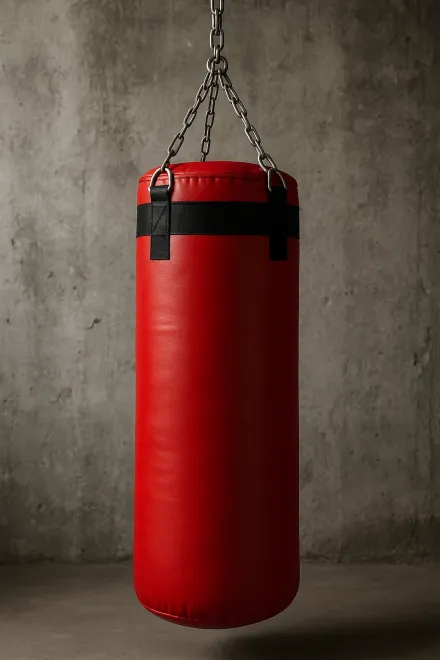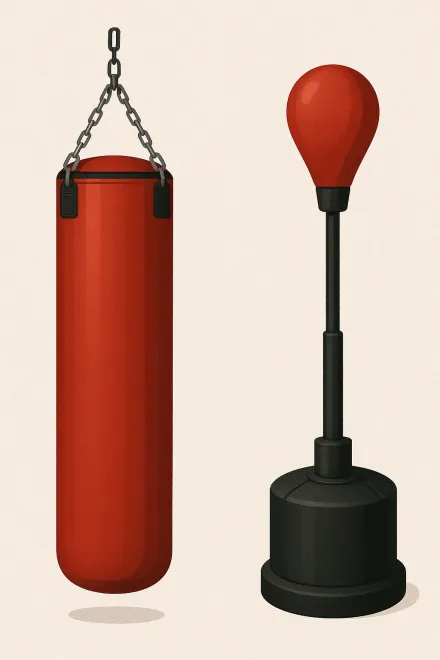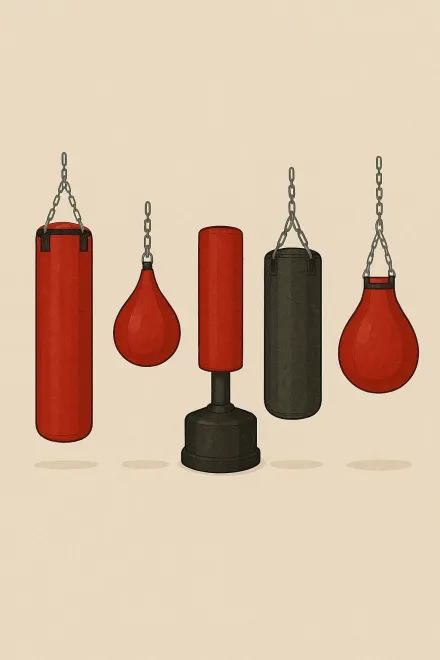Professional punching bags
Professional punching bags are a fundamental tool for any advanced athlete in martial arts, boxing, kickboxing, or muay thai. Unlike basic models, these bags are designed to withstand intensive use, absorb powerful strikes, and keep their shape for years. Choosing the right bag not only ensures durability but also delivers a realistic, effective training experience. In this guide, we will explore the most important features of professional punching bags, buying tips, and usage recommendations to take your performance to the highest level.
See professional punching bags on Amazon
Key features of a professional punching bag
A professional punching bag is not just a sack filled with sand or rags. These models stand out for their resilience, material quality, and ergonomic design. Their main features include:
- Premium materials: high-resistance synthetic leather, genuine leather, or reinforced vinyl built for daily training.
- Uniform filling: compact textile fibers, rubber blends, and high-density foam to absorb impacts without deforming.
- Varied weights: from 30 kg to over 70 kg, matched to the boxer's strength level and goals.
- Secure suspension: reinforced chains, heavy-duty nylon straps, or pro-grade anchor systems to prevent drops.
These qualities make professional bags a long-term investment for those who want to train with intensity and precision.
Types of professional punching bags
The boxing world offers different types of professional bags, each designed to train specific skills:
- Classic cylindrical bag: ideal for complete workouts with both punches and kicks.
- Tear-drop bag: perfect for improving hooks, uppercuts, and close-range movement.
- Free-standing bag: recommended when you cannot drill the ceiling, offering mobility and stability.
- Heavy bag: used in pro gyms, its high weight is perfect for power and precision training.
- Water bag: delivers a more realistic, body-like impact.
Choosing the right type will depend on your goals: technique, power, endurance, or speed.


How to choose the ideal professional bag
Selecting the right bag can make a big difference in your training. Consider the following:
- Bag weight: it should be about half your body weight to provide proper resistance.
- Available space: measure your training area and decide between a hanging or free-standing bag.
- Discipline: boxers benefit from a cylindrical bag, while muay thai prefers longer bags for low kicks.
- Durability: if you train daily, choose leather or top-tier materials.
- Budget: a professional bag is an investment, but there are excellent options without overspending.
Before buying, think through your training objectives and make sure the chosen model matches them.
Advantages of training with a professional punching bag
Investing in a professional punching bag not only improves training quality but also boosts the athlete's physical and mental development. Top advantages include:
- Physical conditioning: being heavier and tougher, pro bags demand more force per strike, strengthening muscles and joints.
- Realism: their fill and weight deliver a near ring-like experience, preparing athletes better for bouts.
- Longevity: while an amateur bag may wear out in months, a professional model can last years even under intense use.
- Versatility: some models let you train multiple disciplines: boxing, kickboxing, muay thai, and even MMA.
- Safety: higher-quality materials reduce injury risks from deformations or weak seams.
For these reasons, professional punching bags are the preferred choice of gyms, coaches, and experienced boxers.
Practical tips to keep your professional bag in prime condition
Proper maintenance is key to ensuring your professional punching bag stays with you for many years. Here are some practical tips:
- Regular cleaning: wipe with a damp cloth after each session to avoid sweat and dust buildup. For leather, apply specific conditioners periodically.
- Check seams and chains: inspect joins and suspension points regularly to prevent unexpected tears.
- Balanced filling: if you notice sagging, redistribute the inner material by gently striking the sides or top up with additional textiles.
- Suitable location: avoid areas exposed to moisture or direct sun, which can degrade materials.
- Use proper gloves: even if the bag is tough, your hands need protection; this also helps extend the bag's lifespan.
With these habits, you will preserve the bag's durability and train with greater comfort and safety.
Frequently asked questions about professional punching bags
What is the ideal weight for a professional punching bag?
The ideal weight depends on the athlete's build and level. As a rule of thumb, the bag should be at least half the boxer's body weight. For example, if you weigh 80 kg, a 40 kg bag is suitable. However, professionals often choose heavier bags, from 50 to 70 kg, to train power and improve endurance.
Which material is best for a professional punching bag?
The best materials are genuine leather and high-end synthetics, as they withstand hard strikes and keep their shape longer. Reinforced vinyl is also popular in gyms, combining durability with a more affordable cost. The choice will depend on usage frequency and available budget.
Is a hanging or a free-standing bag better for professionals?
Hanging bags are usually the preferred option for professionals, as they allow greater mobility, resistance, and realism in strikes. Free-standing bags are practical when a suspension system cannot be installed, but they tend to be less stable under very powerful blows. In a professional gym, a hanging bag is most advisable.
How often should I replace my professional punching bag?
A well-maintained professional bag can last between 5 and 10 years, depending on use. There is no fixed replacement time, but consider changing it if the filling is badly deformed, seams are opening, or it loses firmness on impact, which can affect your training.
Can a professional punching bag be refilled at home?
Yes, you can refill a bag at home, though it takes time and the right materials. Common options include old textiles, chopped foam, or sand sealed in inner bags. However, it is important to distribute the fill evenly to avoid sagging. Many prefer pre-filled bags to ensure an optimal result.
What are the benefits of training with a professional water bag?
Water bags provide an impact sensation very similar to hitting a human body, which improves accuracy and realism. They also absorb strikes better, reducing joint stress. For these reasons, they are increasingly popular among boxers and mixed martial artists.
Is it advisable to hang a punching bag at home?
Yes, you can install a professional bag at home as long as you have a strong ceiling or structure. Make sure to use a quality mount and reinforce the joints. In small apartments or where structure is limited, a free-standing bag is an alternative, although it does not offer the same stability as a hanging one.
What gloves should I use with a professional punching bag?
For training with a professional bag, recommended options are bag gloves or 12 to 16 oz boxing gloves, depending on the user's weight and experience. These protect knuckles and wrists and also help extend the bag's lifespan. Never strike it with bare hands, as that can cause injuries.
